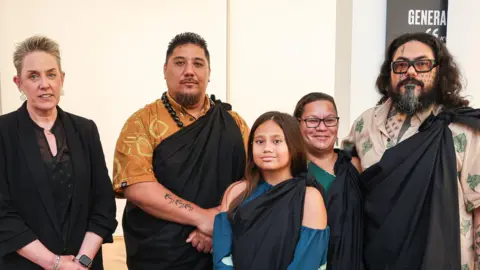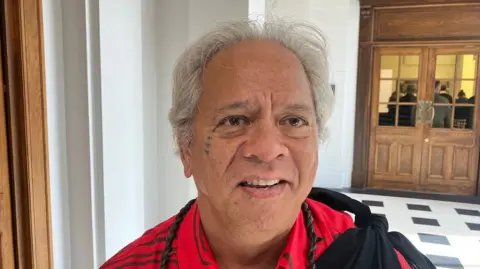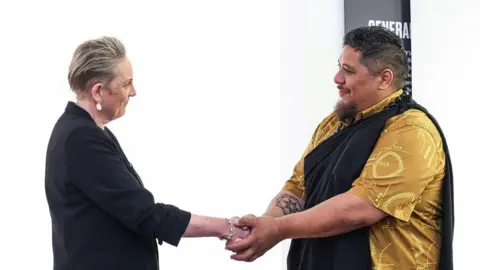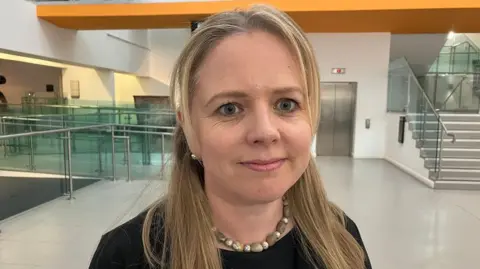'Graved robbed' human remains on journey from Belfast back to Hawaii
 National Museums Northern Ireland
National Museums Northern IrelandAncestral human remains "grave robbed" and brought to Belfast almost 200 years ago have begun their journey back to Hawaii.
The human remains were repatriated in an emotional ceremony held at the Ulster Museum in Belfast, attended by representatives from Hawaii.
Halealoha Ayau from the Hawaiian organisation Hui Iwi Kuamo'o thanked the people of Belfast "for the time that they took care of our ancestors".
"That original taking was illicit, was unethical, was a form of desecration," he told BBC News NI.
Mr Ayau said that "family is paramount" to Hawaiian people.
"We don't have to know who these people are, we just have to know they are Hawaiian.
"The living have a responsibility to them to bring them back, and to replant them into our land."
Mr Ayau said that the remains would again be buried in Hawaii.
"They can continue their journey and that journey is to de-compose, to become elemental again and their spirit allowed to travel on," he said.
"Now they're trapped because this process was interfered with, and when they're trapped as descendants we're trapped.
"And so this allows them the freedom they need to move on, but it allows us the freedom of not having to carry that anguish."

Some human remains and other sacred objects had previously been repatriated by National Museums Northern Ireland (NMNI) to Hawaii in 2022.
That came after NMNI had identified some items stolen from other countries or connected to the slave trade among its collections.
But following the 2022 ceremony, NMNI then located further ancestral human remains (iwi kūpuna) taken from Hawaii in 1840 among its collections.
It is believed that Gordon Augustus Thomson, who travelled from Belfast to Hawaii in 1840, had removed iwi kūpuna from burial caves and donated them to Belfast Natural History and Philosophical Society in 1857.
They were later given to the Belfast Museum and Art Gallery, the precursor to the Ulster Museum, in the early years of the 20th century.
Attendees at the repatriation ceremony were told by Kū'ike Kamakea-ʻŌhelo from the Office of Hawaiian Affairs (OHA) that Thomson was a "grave robber" who had "desecrated the graves of our ancestors".
The ceremony was attended by representatives from OHA, Hui Iwi Kuamo'o, NMNI, and the United States Embassy.
In a speech at the ceremony, the US consul in Northern Ireland, James Applegate, said the remains were being returned to their "rightful place".
 National Museums Northern Ireland
National Museums Northern IrelandThe chief executive of National Museums NI, Kathryn Thomson, said that it was committed to "addressing wrongs of the past".
"I think it's really important that we are always asking ourselves what we have in our collection and why," she told BBC News NI.
"We are very happy today to return these remains to the Hawaiian people.
"We knew that the reason why we had those wasn't legitimate."
The head of curatorial at NMNI, Hannah Crowdy, said that it was a "huge honour" to host the visitors from Hawaii.
"There's lots of evidence when collections came here by means that we don't think are acceptable today," she said.
"And to redress those wrongs and to fully represent and respect different cultures a move like this is really significant for us."

Ms Crowdy said that returning human remains was decided on a "case by case basis."
"We're very much responsive to source communities," she said.
"They're the ones that these remains have special significance for, they're the ones that know the cultural sensitivities of how they should be treated.
"We are responding to different cultures around the world in terms of what they want to happen to their ancestral remains.
"Often it's quite delicate, involved work to try and work out the exact provenance of where the remains are from so we can make those decisions."
Kū'ike Kamakea-ʻŌhelo said that the repatriation of the remains marked a "journey of cultural restoration and healing".
He called those attending the ceremony "stewards of history, heritage and humanity."
"Let this moment serve as a beacon of hope," he said.
